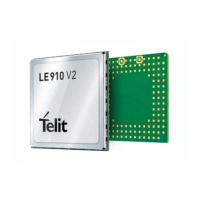Telit LE910 V2 Series AT Commands
80446ST10707A Rev. 0– 2015-11-03
Reproduction forbidden without Telit Communications S.p.A. written authorization - All Rights Reserved page 368 of 509
Mod. 0808 2011-07 Rev.2
When <bytestosend> bytes have been sent, operation is
automatically completed.
If data are successfully sent, then the response is
.
If data sending fails for some reason, an error code is reported.
Note: if secure socket is not enabled using
only test
requests can be made.
Note: if timeout is not set for SSL connection the default timeout
value, set by
is used.
Note: Before sending data through the SSL connection it has
to be established using AT#SSLD.
Note: all special characters are sent like a generic byte.
(For instance: 0x08 is simply sent through the socket and don’t
behave like a BS, i.e. previous character is not deleted).
Test command returns the range of supported values for
parameters
,
and
.
#SSLSENDEXT: (1),(1-1500),(1-5000)
Open the socket in command mode:
at#ssld=1,443,<port>,"IP address",0,1
OK
Give the command specifying total number of bytes as second
parameter:
at#sslsendext=1,256,100
Configure security parameters of a SSL socket - #SSLSECCFG
#SSLSECCFG – Configure security parameters of a SSL socket
<SSId>,
<CipherSuite>,
<auth_mode>
[,<cert_format>]
This command allows configuring SSL connection parameters.
Parameters:
<SSId> - Secure Socket Identifier
1 - Until now SSL block manage only one socket
<CipherSuite>
0 - Chiper Suite is chosen by remote Server [default]
1 - TLS_RSA_WITH_RC4_128_MD5
2 - TLS_RSA_WITH_RC4_128_SHA
3 - TLS_RSA_WITH_AES_128_CBC_SHA
4 - TLS_RSA_WITH_NULL_SHA

